Validation and Application of a Code for Three-Dimensional Analysis of Hydrogen–Steam Behavior in a Nuclear Reactor Containment during Severe Accidents
Abstract
:Featured Application
Abstract
1. Introduction
2. Modeling of Containment Thermal Hydraulics
2.1. Governing Equations
2.2. Modeling for Wall Condensation and Heat Transfer
2.3. Modeling for Passive Autocatalytic Recombiner
3. Results
3.1. Validation of the Models
3.1.1. TOSQAN ISP-47 Test Simulation
3.1.2. Simulation of PAR Experiments
3.2. Application to PWR Containment
3.2.1. Containment Mesh Generation and Source Modeling
3.2.2. Steam and Hydrogen Behaviors in the Containment
4. Discussion
5. Conclusions
Author Contributions
Funding
Institutional Review Board Statement
Informed Consent Statement
Data Availability Statement
Conflicts of Interest
Nomenclature
| Ratio of fog mass-to-gas mass | |
| Normal distance from wall to cell center | |
| Density | |
| Specific heat | |
| Coefficient for transient friction force | |
| Bulk condensation coefficient | |
| Water vapor diffusivity at wall | |
| Darcy coefficient vector | |
| Forchheimer coefficient tensor | |
| Gravity vector | |
| Turbulent fog diffusivity | |
| Heat transfer coefficient | |
| Mass diffusion coefficient | |
| Sensible enthalpy | |
| Mass diffusion flux vector | |
| Thermal conductivity | |
| Kinetic energy () | |
| Mass | |
| Pressure | |
| Pr | Prandtl number |
| Ratio of thermal energy transferred to gas | |
| Wall heat flux | |
| Heat flux vector | |
| Recombination rate | |
| Reynolds stress tensor | |
| Sink or source | |
| Sc | Schmidt number |
| Temperature | |
| Dimensionless temperature | |
| time | |
| Dimensionless velocity | |
| Shear velocity | |
| Velocity vector | |
| Dimensionless distance | |
| Mass fraction of gas species i |
References
- TEPCO. Fukushima Nuclear Accident Analysis Report. 2012. Available online: http://www.tepco.co.jp/en/press/corp-com/release/betu12_e/images/120620e0104.pdf (accessed on 5 January 2023).
- Yanez, J.; Kuznetsov, M.; Souto-Iglesias, A. An analysis of the hydrogen explosion in the Fukushima-Daiichi accident. Int. J. Hydrogen Energy 2015, 40, 8261–8280. [Google Scholar] [CrossRef]
- IAEA-TECDOC-1661; Mitigation of Hydrogen Hazards in Severe Accidents in Nuclear Power Plants. IAEA: Vienna, Austria, 2011.
- Bentaib, A.; Meynet, N.; Bleyer, A. Overview on Hydrogen Risk Research and Development Activities: Methodology and Open Issues. Nucl. Eng. Technol. 2015, 47, 26–32. [Google Scholar] [CrossRef]
- IAEA-TECDOC-1939; Developments in the Analysis and Management of Combustible Gases in Severe Accidents in Water Cooled Reactors Following the Fukushima Daiichi Accident. IAEA: Vienna, Austria, 2020.
- Papini, D.; Andreani, M.; Niceno, B.; Prasser, H.-M.; Steiner, P.; Klugel, J.-U. Simulation of hydrogen distribution in the containment during a severe accident with fast hydrogen-steam release. In Proceedings of the International Topical Meeting on Nuclear Reactor Thermal Hydraulics, Chicago, IL, USA, 30 August–4 September 2015. [Google Scholar]
- FLUENT User’s Guide; Release 13.0; ANSYS, Inc.: Canonsburg, PA, USA, 2010.
- CFX-Solver Theory Guide; Release 12.1; ANSYS, Inc.: Canonsburg, PA, USA, 2009.
- Siemens Industries Digital Software. Simcenter STAR-CCM+, version 2023; Siemens: Munich, Germany, 2023. [Google Scholar]
- Travis, J.R.; Royl, P.; Xiao, J.; Necker, G.A.; Redlinger, R.; Spore, J.W.; Lam, K.L.; Wilson, T.L.; Müller, C.; Nichols, B.D. GASFLOW: A Computational Fluid Dynamics Code for Gases Aerosols, and Combustion; KIT: Amsterdam, The Netherlands, 2011; Volume 1. [Google Scholar]
- Andreani, M.; Smith, B. On the Use of the Standard k-ε Turbulence Model in GOTHIC to Simulate Buoyant Flows with Light Gases. In Proceedings of the 10th International Topical Meeting on Nuclear Reactor Thermal Hydraulics (NURETH-10), Seoul, Republic of Korea, 5–9 October 2003. [Google Scholar]
- Kudriakov, S.; Dabbene, F.; Studer, E.; Beccantini, A.; Magnaud, J.P.; Paillere, H.; Bentaib, A.; Bleyer, A.; Malet, J.; Caroli, C. The TONUS CFD Code for Hydrogen Risk Analysis: Physical Models, Numerical Schemes and Validation Matrix. Nucl. Eng. Des. 2008, 238, 551–565. [Google Scholar] [CrossRef]
- OpenFOAM: The Open Source CFD Toolbox User Guide, version v2312; OpenCFD Limited: Berkshire, UK, 2023.
- Royl, P.; Rochholz, H.; Breitung, W.; Travis, J.R.; Necker, G. Analysis of Steam and Hydrogen Distributions with PAR Mitigation in NPP Containments. Nucl. Eng. Des. 2000, 202, 231–248. [Google Scholar] [CrossRef]
- Xiao, J.; Breitung, W.; Kuznetsov, M.; Zhang, H.; Travis, J.R.; Redlinger, R.; Jordan, T. GASFLOW-MPI: A new 3-D parallel All-speed CFD Code for Turbulent Dispersion and Combustion Simulations Part II: First analysis of the hydrogen explosion in Fukushima Daiichi Unit 1. Int. J. Hydrogen Energy 2017, 42, 8369–8381. [Google Scholar] [CrossRef]
- Xiong, J.; Yang, Y.; Cheng, X. CFD Application to Hydrogen Risk Analysis and PAR Qualification. Sci. Technol. Nucl. Install. 2009, 2009, 213981. [Google Scholar] [CrossRef]
- Martin-Valdepenas, J.M.; Jimenez, M.A.; Martin-Fuertes, F.; Fernandez, J.A. Improvements in a CFD Code for Analysis of Hydrogen Behavior within Containments. Nucl. Eng. Des. 2007, 237, 627–647. [Google Scholar] [CrossRef]
- Lopez-Alonso, E.; Papini, D.; Jimenez, G. Hydrogen distribution and Passive Autocatalytic Recombiner (PAR) Mitigation in a PWR-KWU Containment Type. Ann. Nucl. Energy 2017, 109, 600–611. [Google Scholar] [CrossRef]
- Kanik, M.E.; Noori-kalkhoran, O.; Fernandez-Cosials, K.; Gei, M. 3D Analysis of Hydrogen Distribution and Its Mitigation Using Passive Autocatalytic Recombiners (PARs) Inside VVER-1000 Containment. Energies 2023, 16, 6612. [Google Scholar] [CrossRef]
- Raman, R.K.; Iyer, K.N.; Rao, R.S.; Gaikwad, A.J.; Sharma, S.K. CFD Studies of Hydrogen Distribution in 220 MWe PHWR Containment. Nucl. Eng. Des. 2022, 396, 111898. [Google Scholar] [CrossRef]
- Kelm, S.; Kampili, M.; Liu, X.; George, A.; Schumacher, D.; Druska, C.; Struth, S.; Kuhr, A.; Ramacher, L.; Allelein, H.-J.; et al. The Tailored CFD Package containment FOAM for Analysis of Containment Atmosphere Mixing, H2/CO Mitigation and Aerosol Transport. Fluid 2021, 6, 100. [Google Scholar] [CrossRef]
- Kim, J.; Jung, J.; Kim, D. Methodology Development for Evaluation of Hydrogen Safety in a NPP Containment using OpenFOAM. In Proceedings of the Technical Meeting on Hydrogen Management in Severe Accidents, Vienna, Austria, 25–28 September 2018. [Google Scholar]
- Kim, J. Modeling and Validation of Steam Condensation for Containment Thermal Hydraulic Analysis during a Severe Accident. In Proceedings of the Transactions of the Korean Nuclear Society Spring Meeting, Jeju, Republic of Korea, 8–10 May 2024; Korean Nuclear Society: Daejeon, Republic of Korea, 2024. [Google Scholar]
- Status Report 83—Advanced Power Reactor 1400 MWe (APR1400); KHNP: Gyeongju, Republic of Korea, 2011.
- Gerber, A.G.; Kermani, M.J. A pressure Based Eulerian–Eulerian Multi-phase Model for Non-equilibrium Condensation in Transonic Steam Flow. Int. J. Heat Mass Transf. 2004, 47, 2217–2231. [Google Scholar] [CrossRef]
- Chilton, T.H.; Colburn, A.P. Mass Transfer (absorption) coefficients Prediction from Data on Heat Transfer and Fluid Flow. Ind. Eng. Chem. 1934, 26, 1183–1187. [Google Scholar] [CrossRef]
- Jayatilleke, C.L.V. The Influence of Prandtl Number and Surface Roughness on the Resistance of the Laminar Sublayer to Momentum and Heat Transfer. Prog. Heat Mass Transf. 1969, 1, 193–321. [Google Scholar]
- Halouane, Y.; Dehbi, A. CFD Prediction of Hydrogen Passive Autocatalytic Recombiner Performance under Counter-current Flow Conditions. Int. J. Hydrogen Energy 2020, 45, 10247–10256. [Google Scholar] [CrossRef]
- Kelm, S.; Jahn, W.; Reinecke, E.-A. Operational Behaviour of Catalytic Recombiners Experimental Results and Modelling Approaches. In Proceedings of the OECD/NEA Workshop on the Experiments and CFD Code Application to Nuclear Reactor Safety, Grenoble, France, 10–12 September 2008. [Google Scholar]
- Bachellerie, E.; Arnould, F.; Auglaire, N.; de Boeck, B.; Braillard, O.; Eckardt, B.; Ferroni, F.; Moffett, R. Generic Approach for Designing and Implementing a Pass Autocatalytic Recombiner PAR-System in Nuclear Power Plant Containments. Nucl. Eng. Des. 2003, 221, 151–165. [Google Scholar] [CrossRef]
- Park, J.W.; Koh, B.R.; Suh, K.Y. Demonstrative Testing of Honeycomb Passive Autocatalytic Recombiner for Nuclear Power Plant. Nucl. Eng. Des. 2011, 241, 4280–4288. [Google Scholar] [CrossRef]
- Kim, C.H.; Sung, J.J.; Ha, S.J.; Yeo, I.S. Analysis Method for the Design of a Hydrogen Mitigation System with Passive Autocatalytic Recombiners in OPR1000, PBNC2014-072. In Proceedings of the 19th Pacific Basin Nuclear Conference (PBNC 2014), Vancouver, BC, Canada, 24–28 August 2014. [Google Scholar]
- Burcharth, H.F.; Andersen, O.H. On the One-dimensional Steady and Unsteady Porous Flow Equations. Coast. Eng. 1995, 24, 233–257. [Google Scholar] [CrossRef]
- Devolder, B.; Troch, P.; Rauwoens, P. Performance of a buoyancy-modified k-ω and k-ω SST turbulence model for simulating wave breaking under regular waves using OpenFOAM. Coast. Eng. 2018, 138, 49–65. [Google Scholar] [CrossRef]
- Mimouni, S.; Mechitoua, N.; Foissac, A.; Hassanaly, M.; Ouraou, M. CFD Modeling of Wall Steam Condensation: Two-Phase Flow Approach versus Homogeneous Flow Approach. Sci. Technol. Nucl. Install. 2011, 1, 941239. [Google Scholar] [CrossRef]
- Kanzleiter, T.; Gupta, S.; Fischer, K.; Ahrens, G.; Langer, G.; Kuhnel, A.; Poss, G.; Langrock, G.; Funke, F. Hydrogen and Fission Product Issues Relevant for Containment Safety Assessment under Severe Accident Conditions; Reactor Safety Research Project 1501326, OECD-NEA THAI Project; OECD: Paris, France, 2010. [Google Scholar]
- Kim, J.; Jung, J. Evaluation of Hydrogen Recombination Characteristics of a PAR using SPARC PAR Experimental Results. Nucl. Eng. Technol. 2023, 55, 4382–4394. [Google Scholar] [CrossRef]
- Gauntt, R.O.; Cash, J.E.; Cole, R.K.; Erickson, C.M.; Humphries, L.L.; Rodriguez, S.B.; Young, M.F. MELCOR Computer Code Manuals; Reference Manuals Version 1.8.6; Office of Nuclear Regulatory Research, U.S. Nuclear Regulatory Commission: Washington, DC, USA, 2005; Volume 2, Rev. 3, NUREG/CR-6119, SAND 2005-5713.
- Kim, J.; Hong, S.; Park, K.H.; Kim, J.H.; Oh, J.Y. Experimental Study on a Hydrogen Stratification Induced by PARs Installed in a Containment. Energies 2020, 13, 5552. [Google Scholar] [CrossRef]

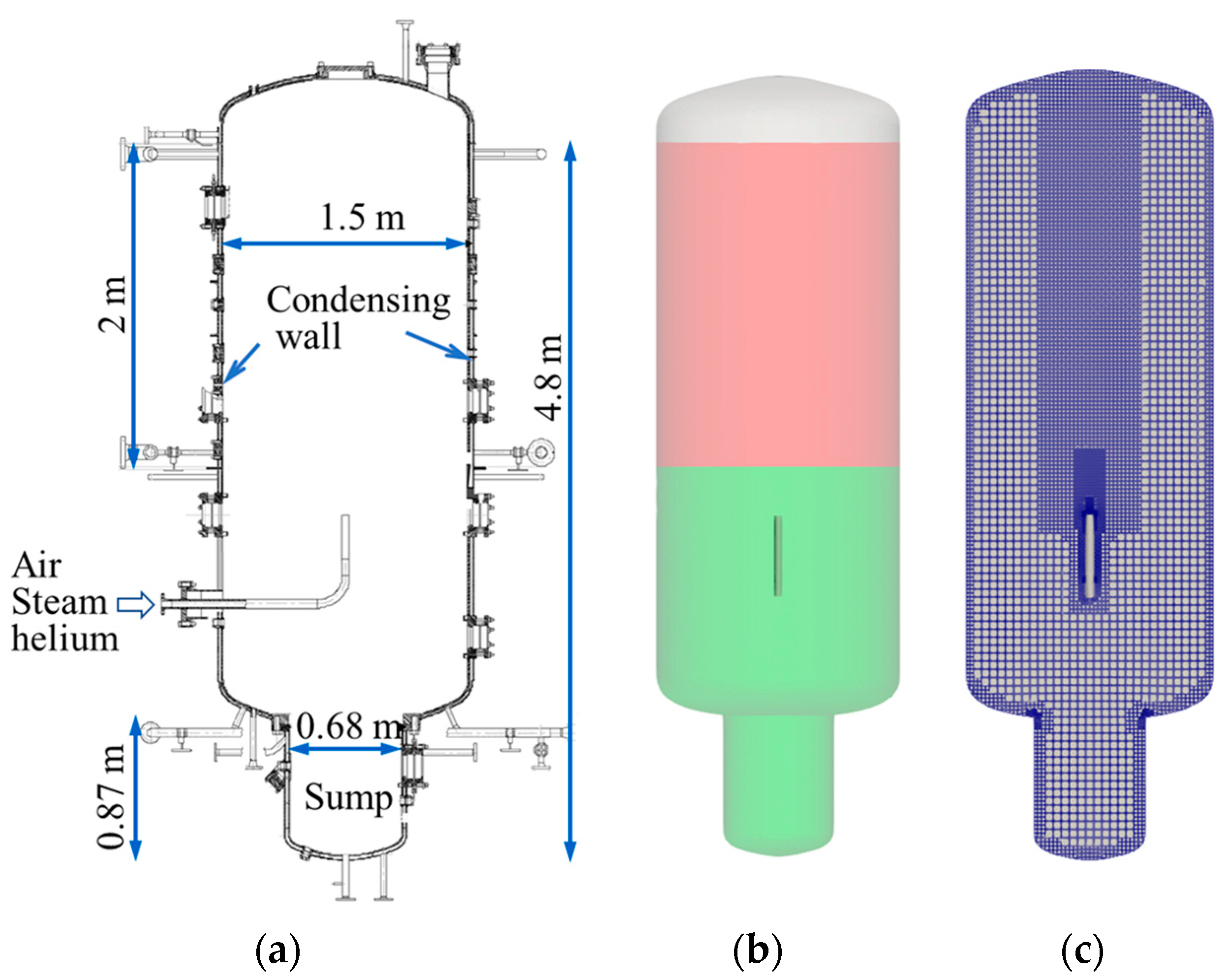
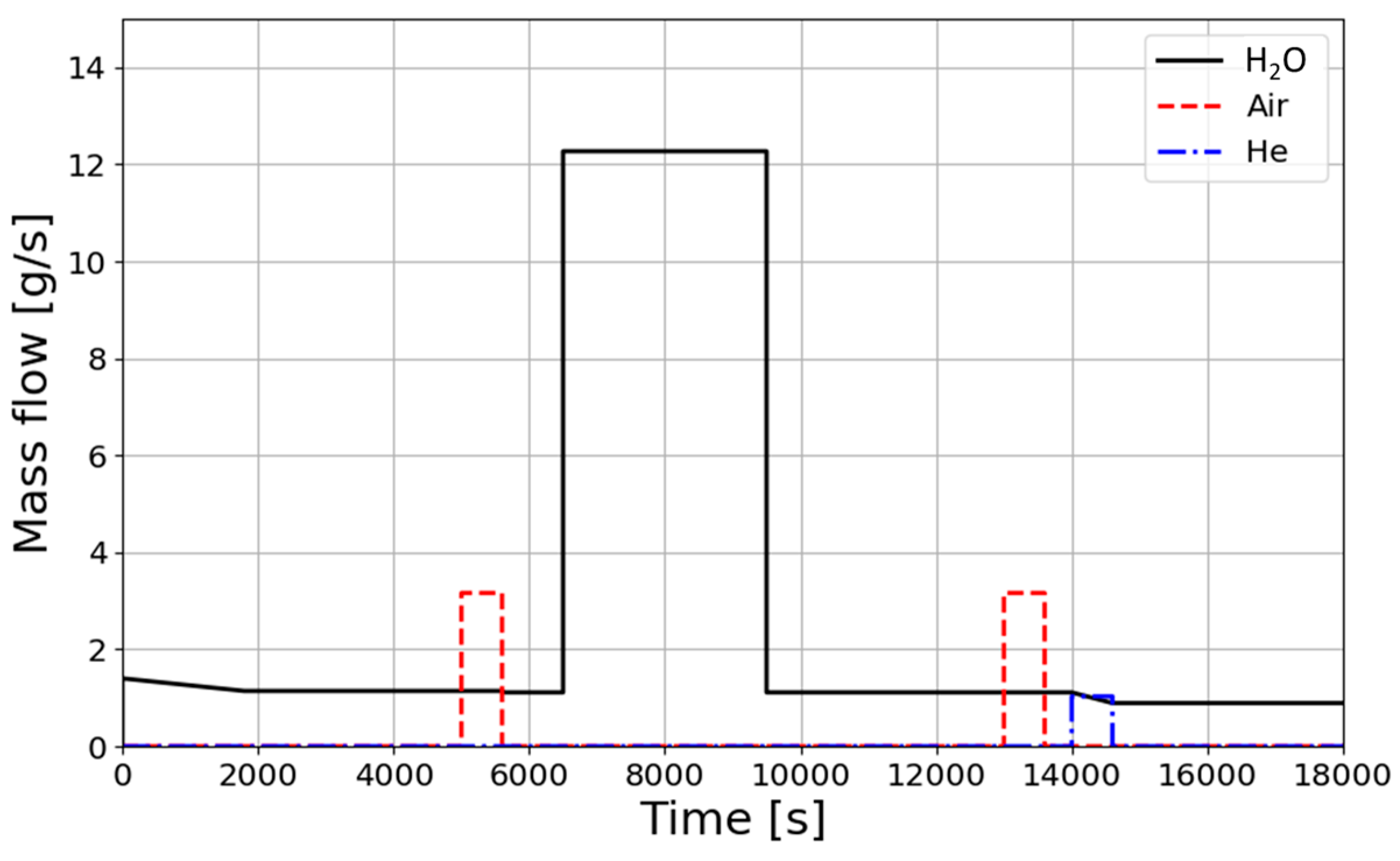
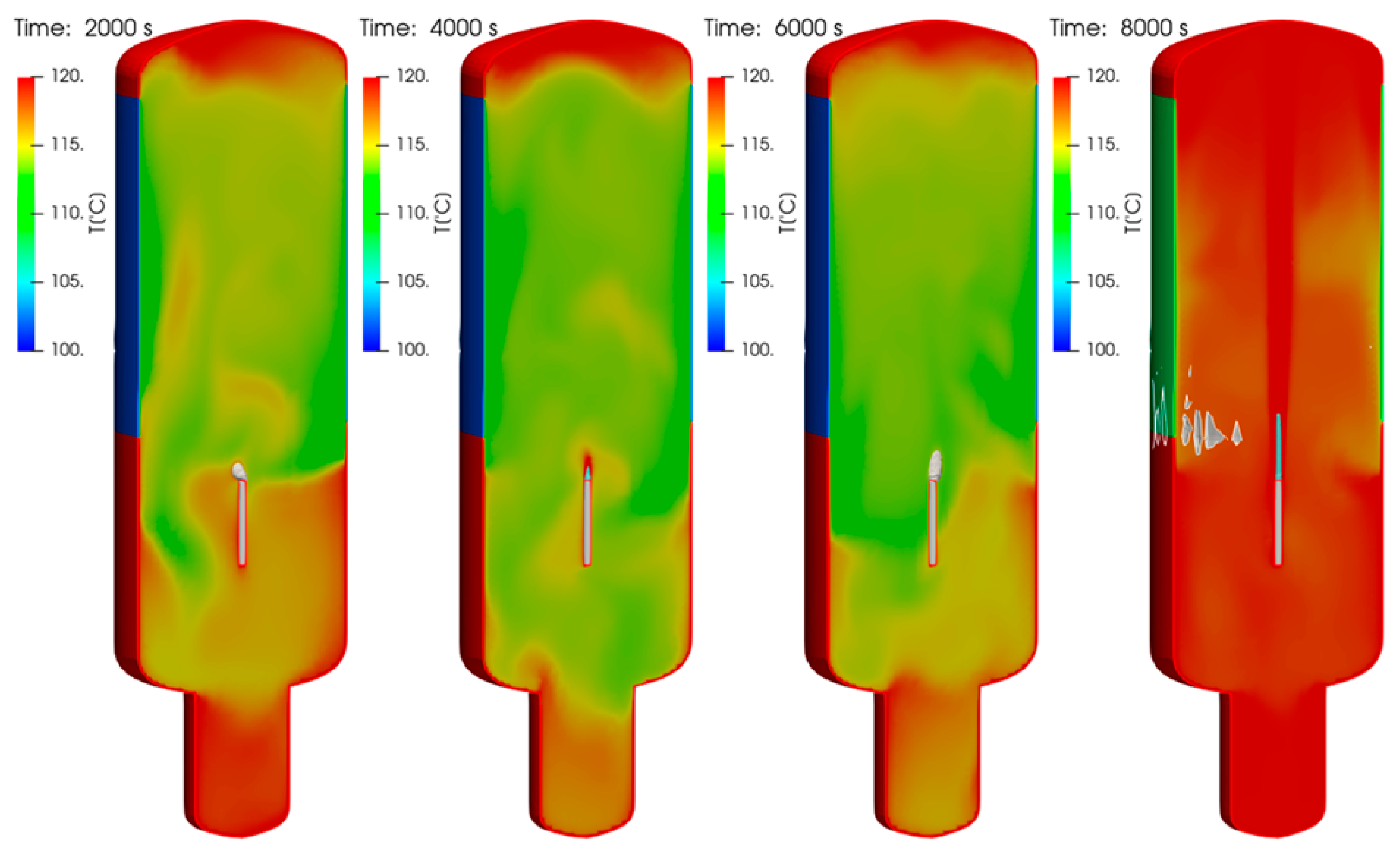
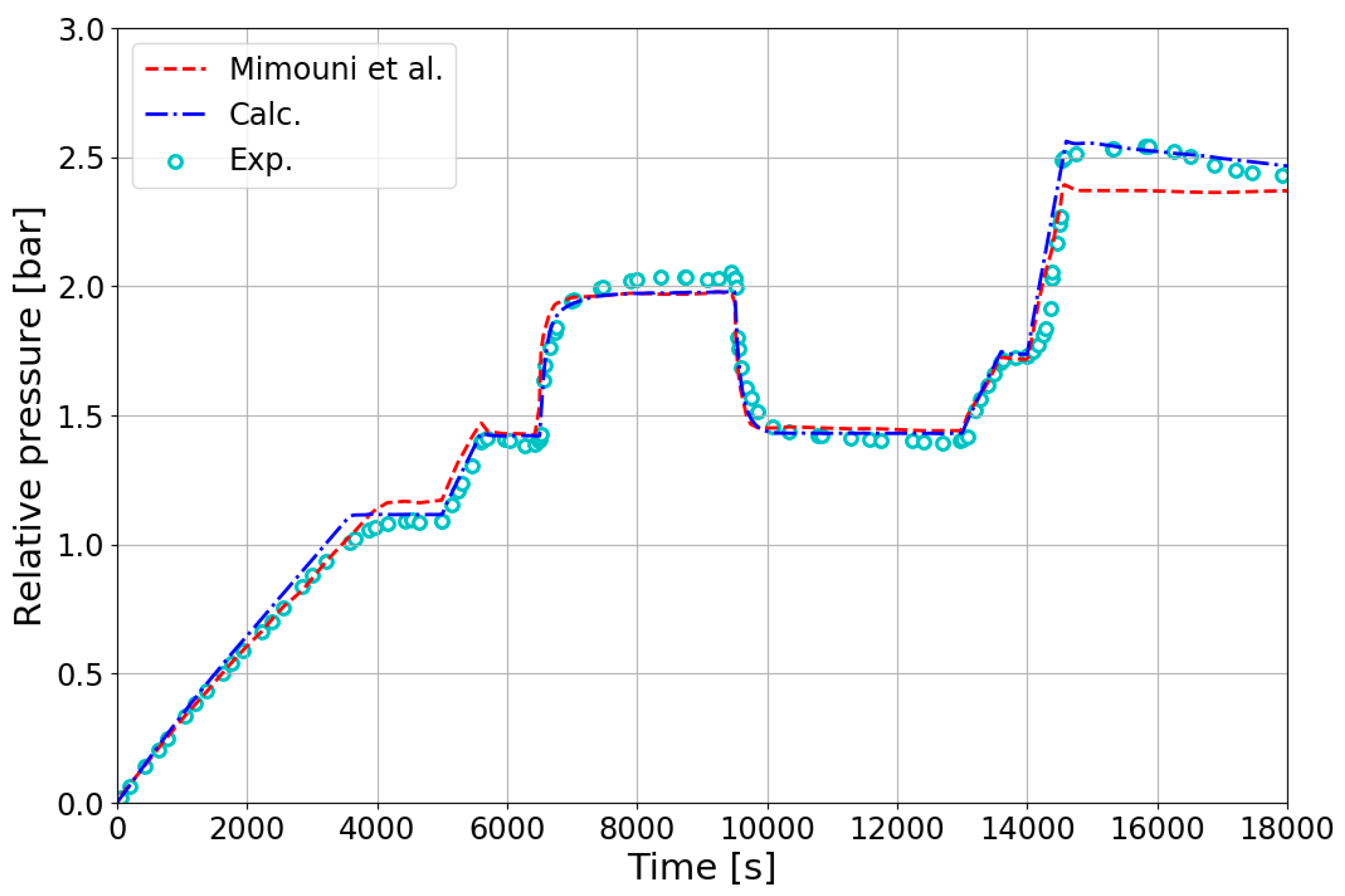
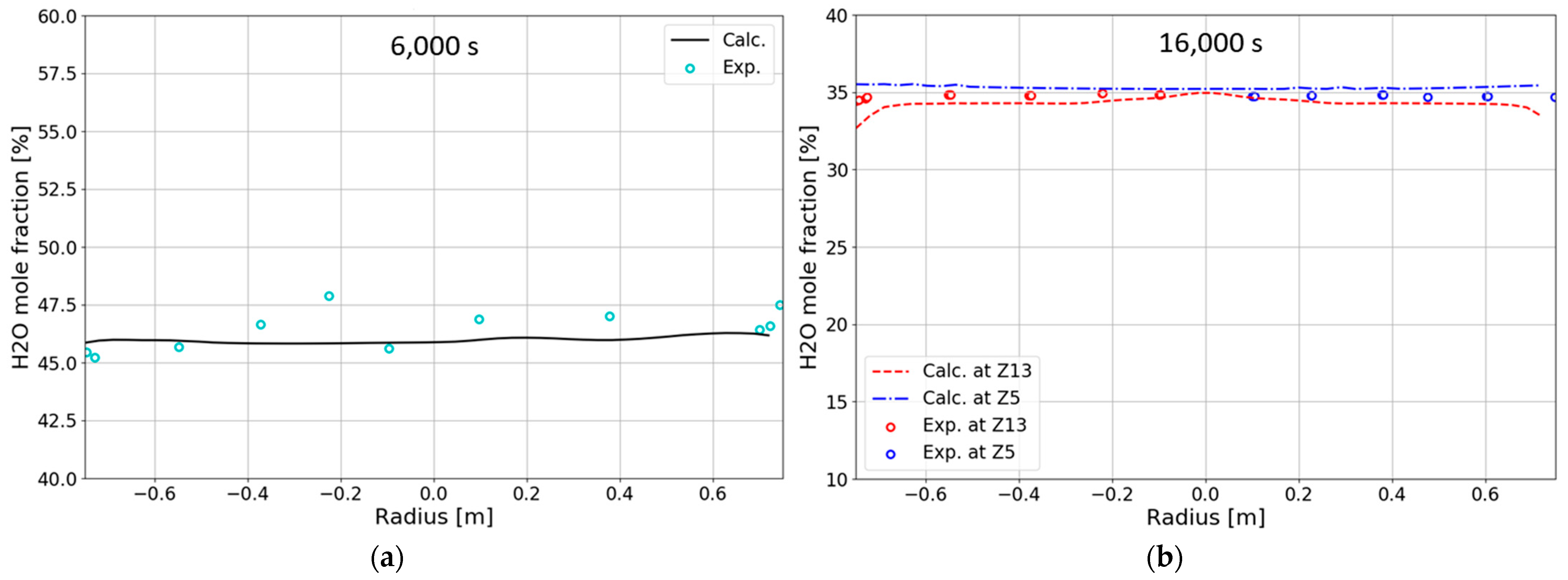


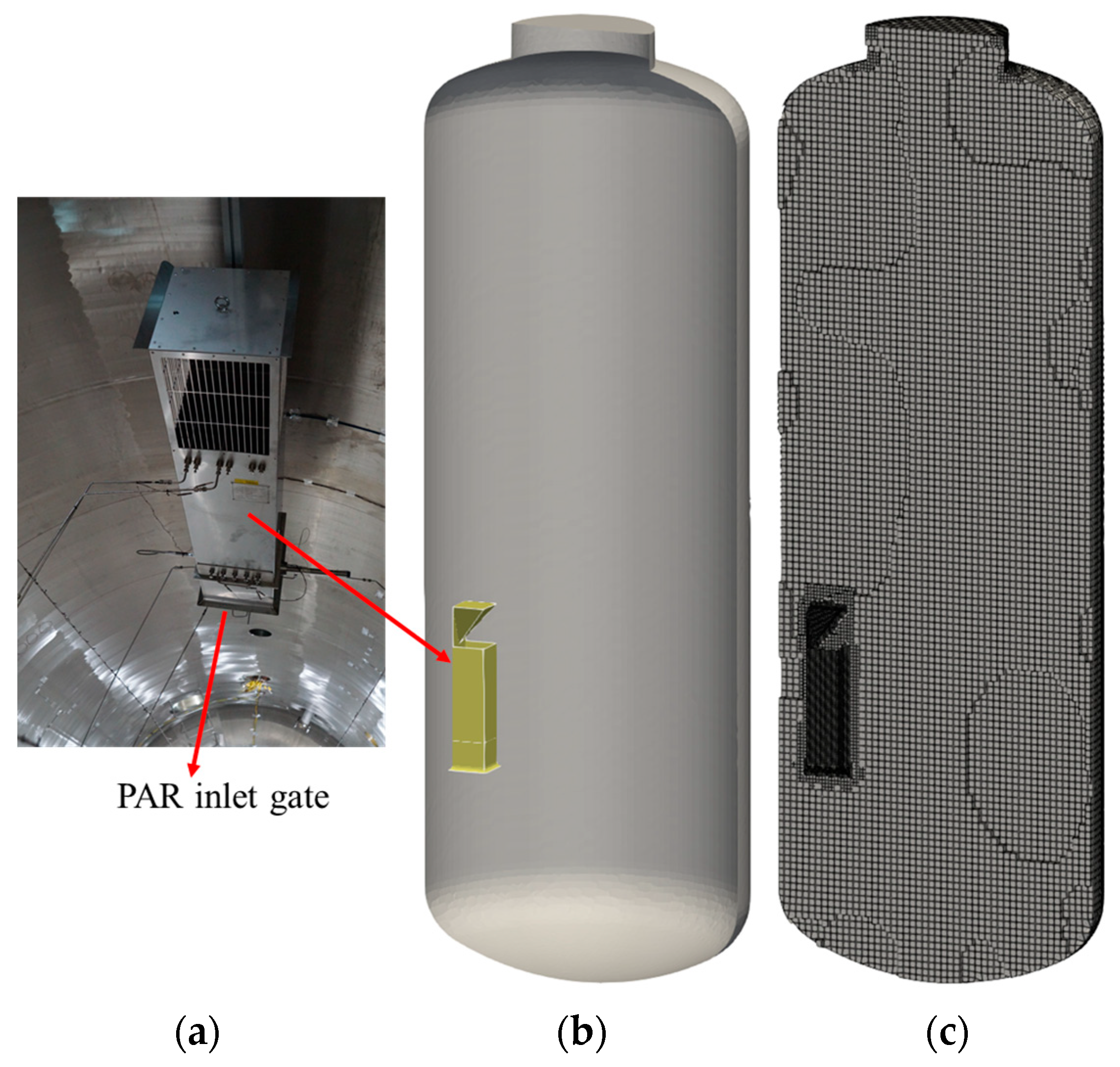

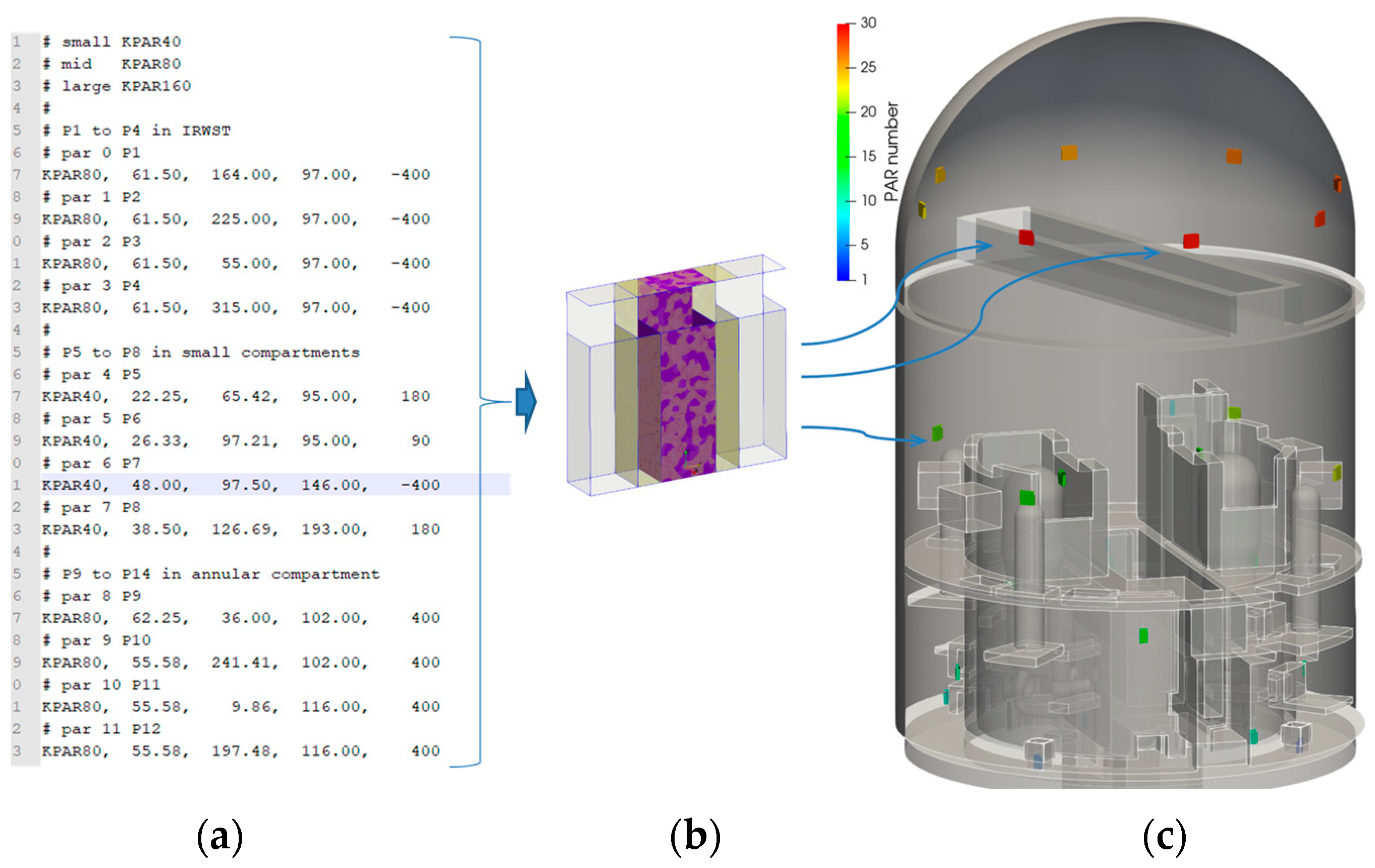

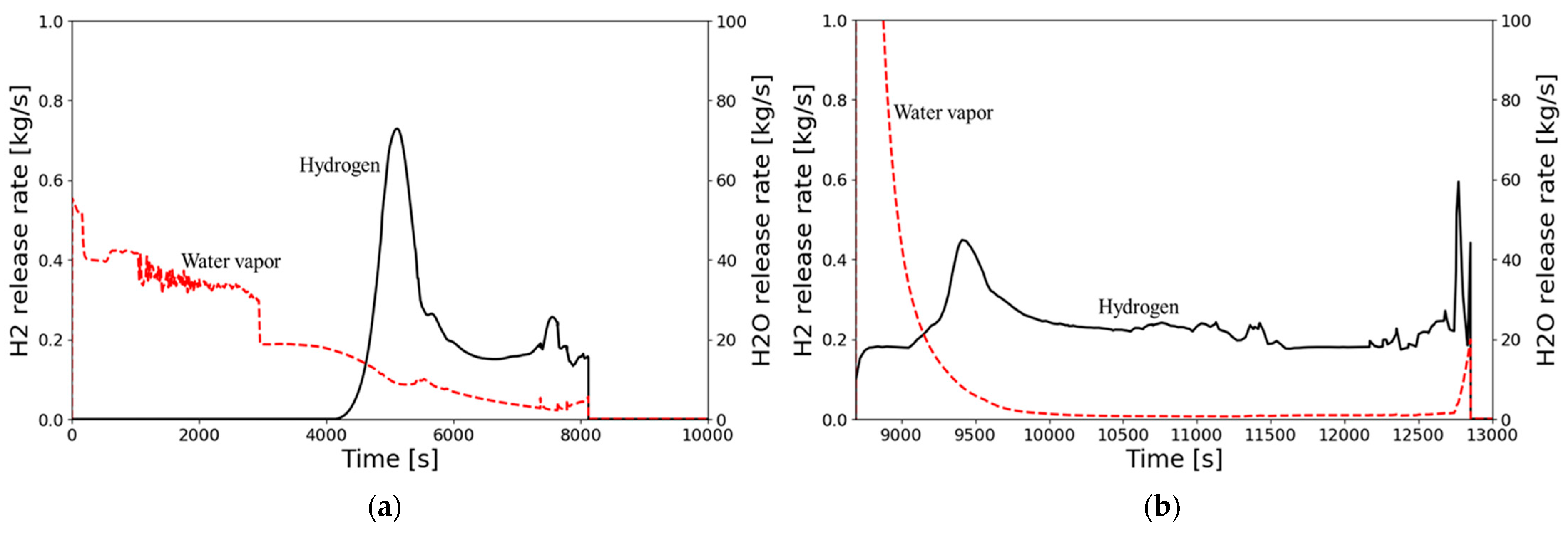

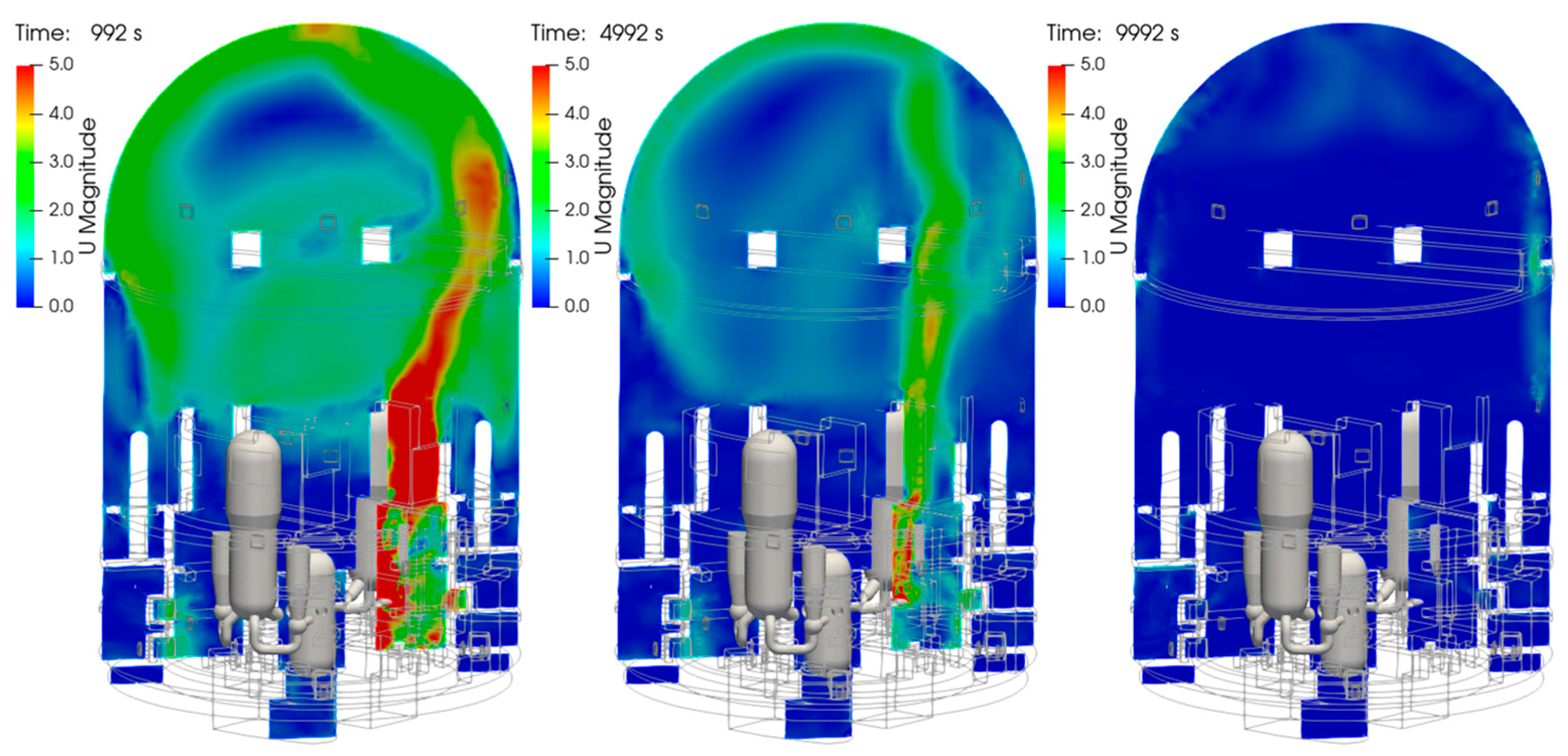
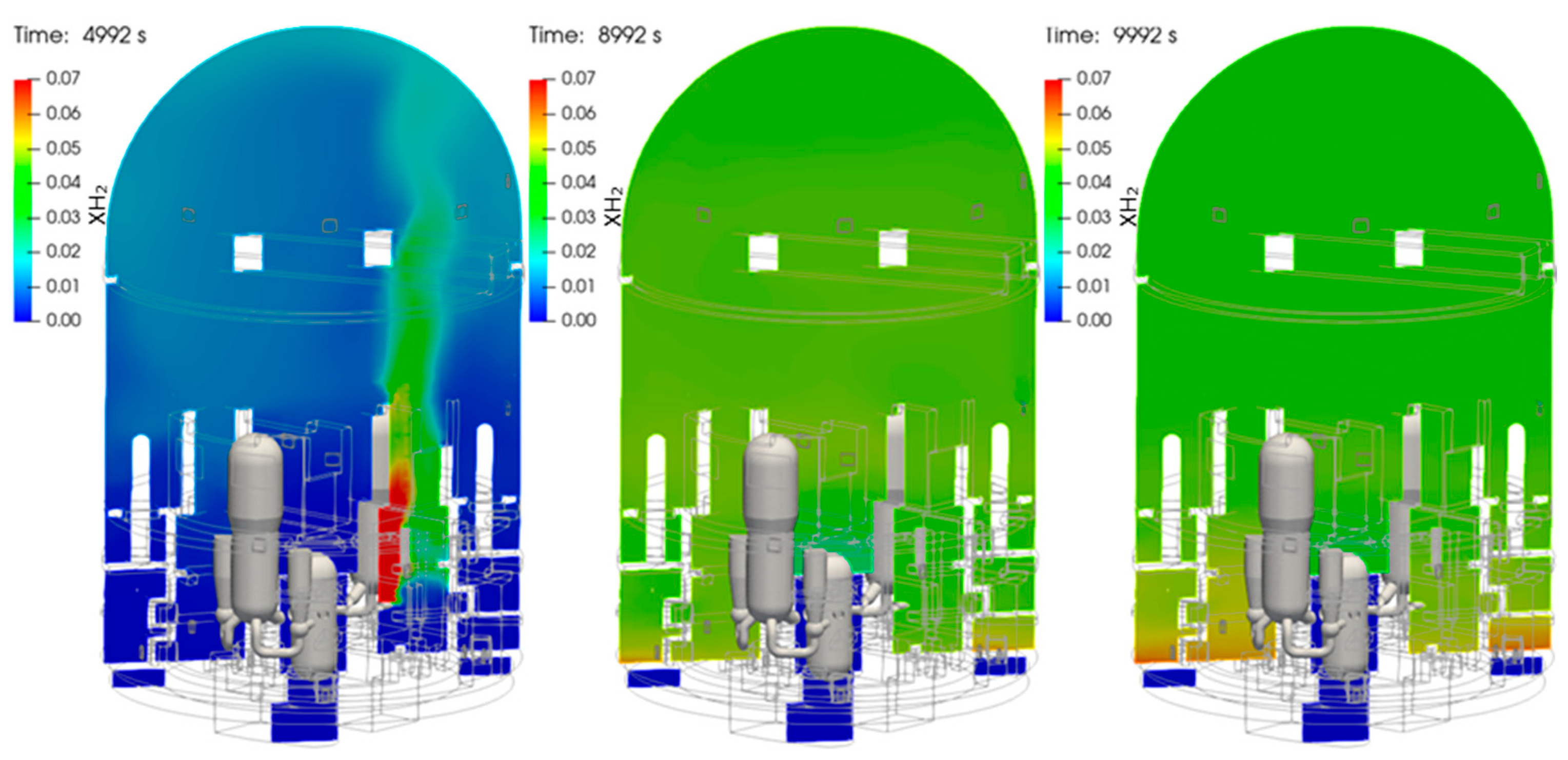
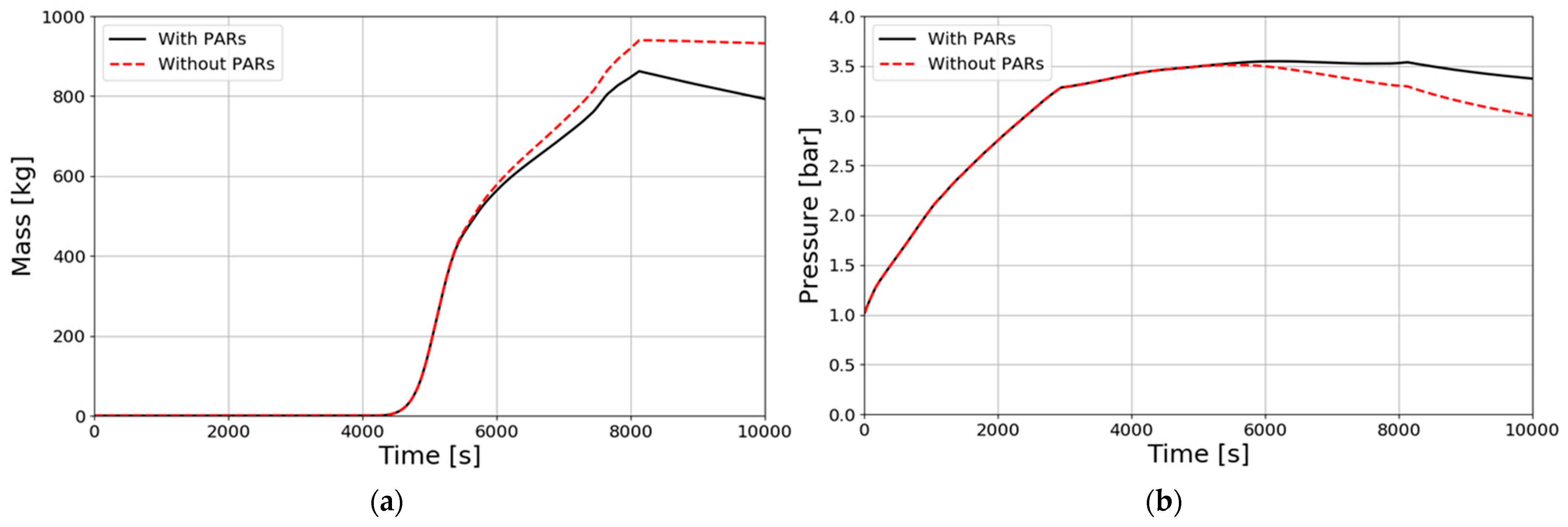
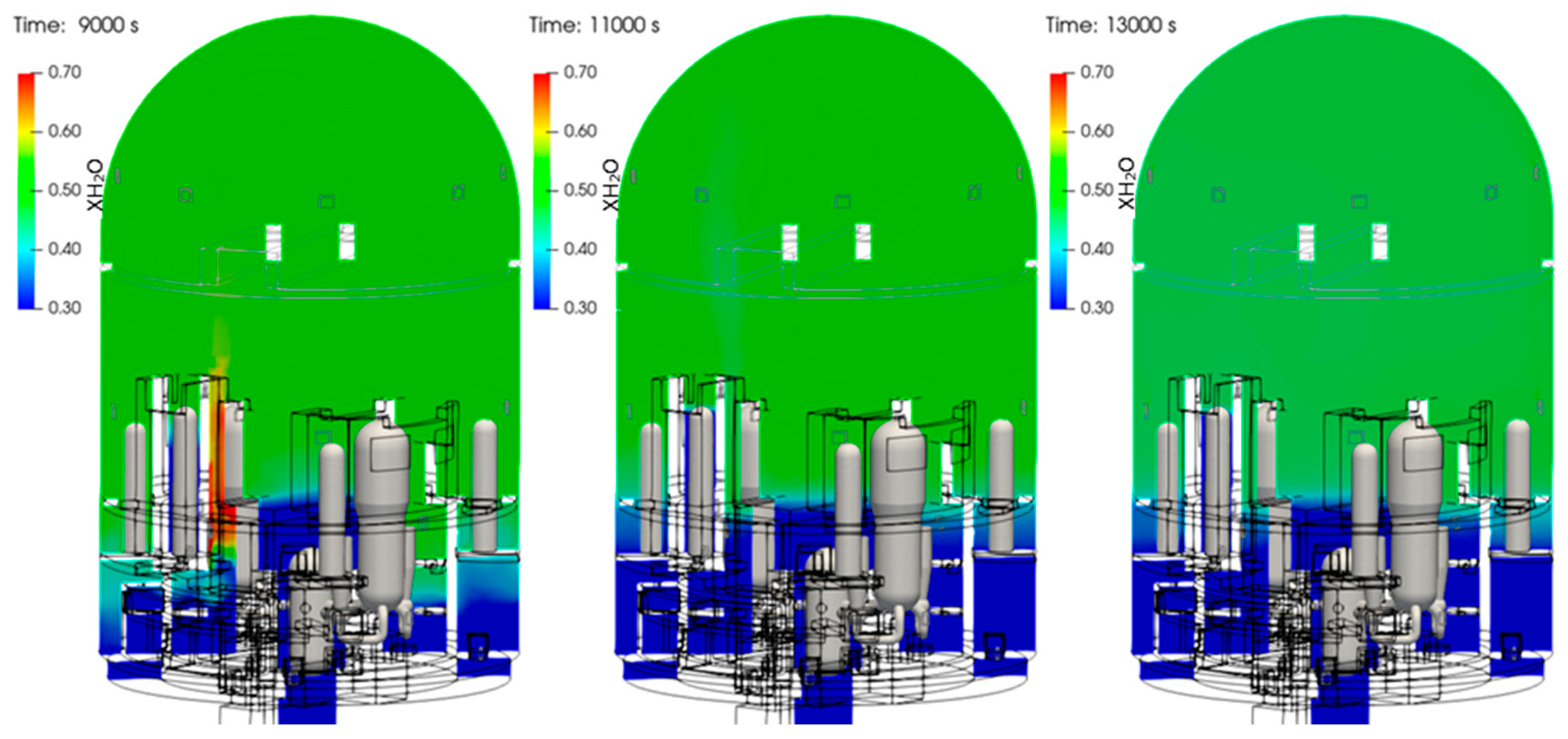

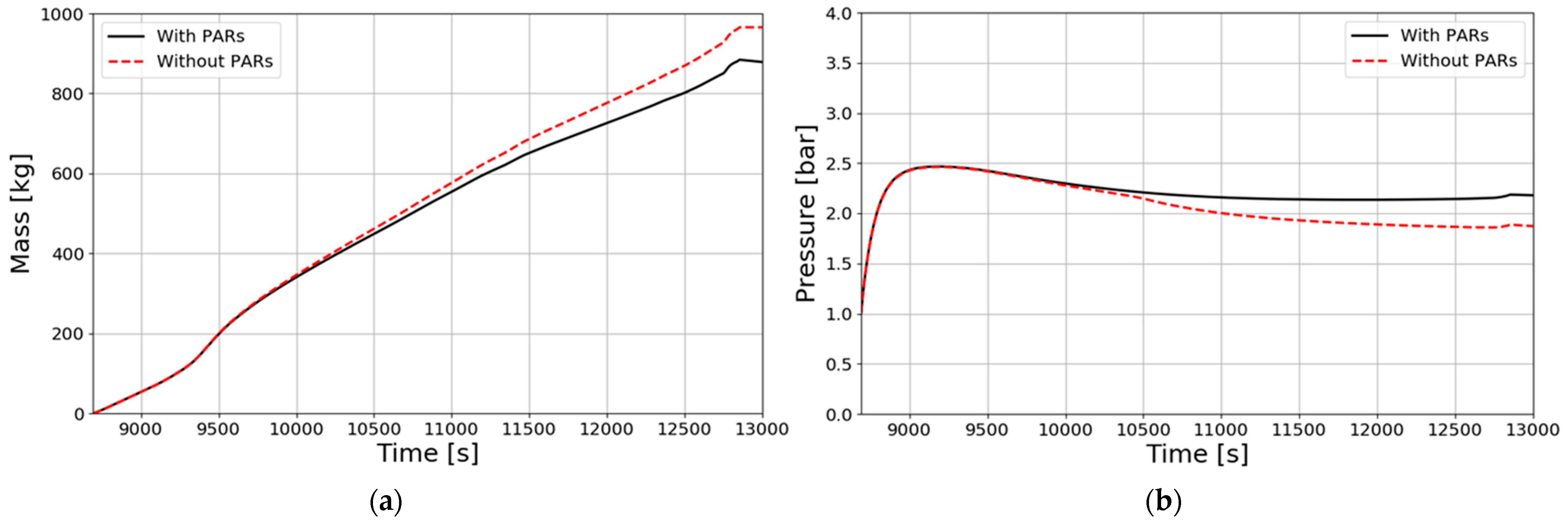
| PAR Vendor | PAR Correlation | Unit |
|---|---|---|
| AREVA | X[-], p[bar] | |
| AECL | X[%], p[bar] | |
| NIS | X[-], p[Pa] | |
| KNT | X[%], p[bar] | |
| CERACOMB | X[%], p[bar] |
| Accident Scenario | Water Vapor Mass | Hydrogen Mass |
|---|---|---|
| SBLOCA | 163 ton | 950 kg |
| SBO | 67 ton | 975 kg |
Disclaimer/Publisher’s Note: The statements, opinions and data contained in all publications are solely those of the individual author(s) and contributor(s) and not of MDPI and/or the editor(s). MDPI and/or the editor(s) disclaim responsibility for any injury to people or property resulting from any ideas, methods, instructions or products referred to in the content. |
© 2024 by the authors. Licensee MDPI, Basel, Switzerland. This article is an open access article distributed under the terms and conditions of the Creative Commons Attribution (CC BY) license (https://creativecommons.org/licenses/by/4.0/).
Share and Cite
Kim, J.; Lim, K. Validation and Application of a Code for Three-Dimensional Analysis of Hydrogen–Steam Behavior in a Nuclear Reactor Containment during Severe Accidents. Appl. Sci. 2024, 14, 6695. https://doi.org/10.3390/app14156695
Kim J, Lim K. Validation and Application of a Code for Three-Dimensional Analysis of Hydrogen–Steam Behavior in a Nuclear Reactor Containment during Severe Accidents. Applied Sciences. 2024; 14(15):6695. https://doi.org/10.3390/app14156695
Chicago/Turabian StyleKim, Jongtae, and Kukhee Lim. 2024. "Validation and Application of a Code for Three-Dimensional Analysis of Hydrogen–Steam Behavior in a Nuclear Reactor Containment during Severe Accidents" Applied Sciences 14, no. 15: 6695. https://doi.org/10.3390/app14156695





